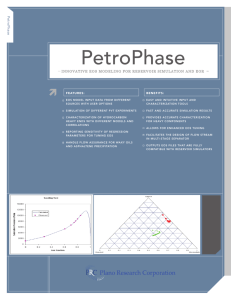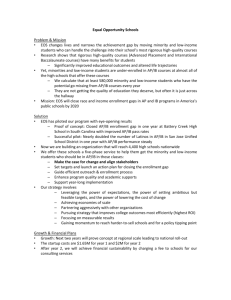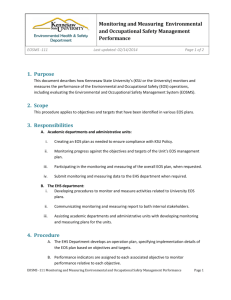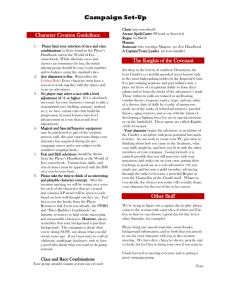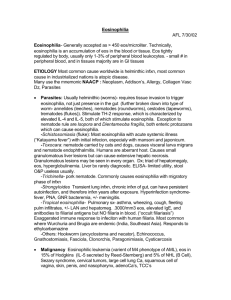doc - EOS
advertisement
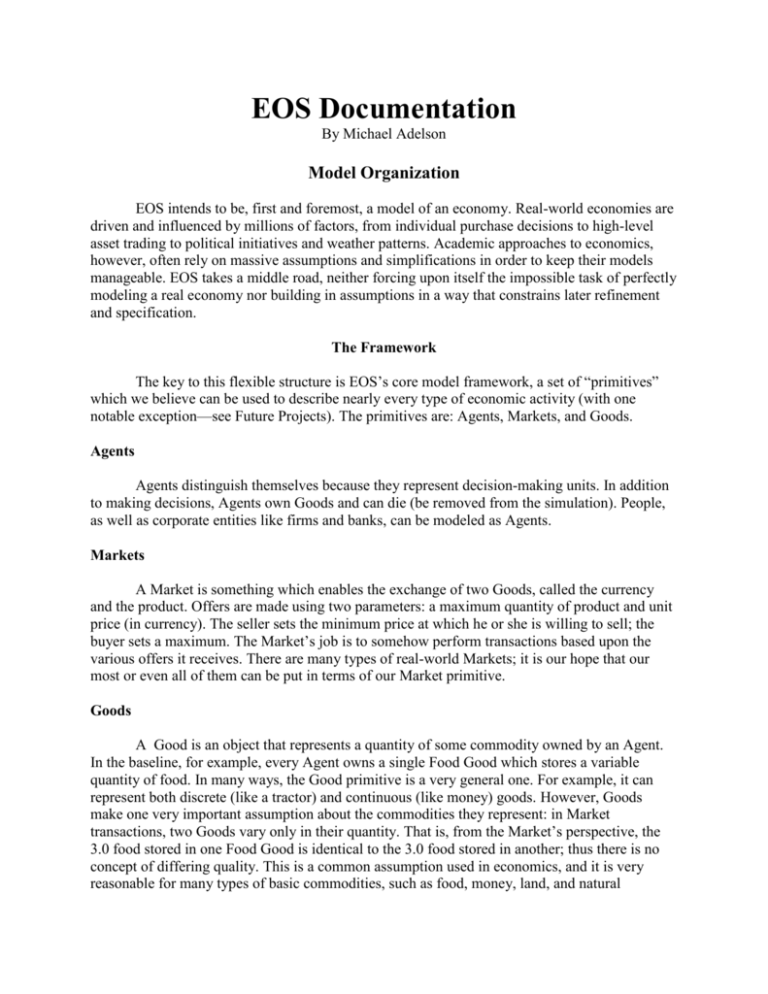
EOS Documentation
By Michael Adelson
Model Organization
EOS intends to be, first and foremost, a model of an economy. Real-world economies are
driven and influenced by millions of factors, from individual purchase decisions to high-level
asset trading to political initiatives and weather patterns. Academic approaches to economics,
however, often rely on massive assumptions and simplifications in order to keep their models
manageable. EOS takes a middle road, neither forcing upon itself the impossible task of perfectly
modeling a real economy nor building in assumptions in a way that constrains later refinement
and specification.
The Framework
The key to this flexible structure is EOS’s core model framework, a set of “primitives”
which we believe can be used to describe nearly every type of economic activity (with one
notable exception—see Future Projects). The primitives are: Agents, Markets, and Goods.
Agents
Agents distinguish themselves because they represent decision-making units. In addition
to making decisions, Agents own Goods and can die (be removed from the simulation). People,
as well as corporate entities like firms and banks, can be modeled as Agents.
Markets
A Market is something which enables the exchange of two Goods, called the currency
and the product. Offers are made using two parameters: a maximum quantity of product and unit
price (in currency). The seller sets the minimum price at which he or she is willing to sell; the
buyer sets a maximum. The Market’s job is to somehow perform transactions based upon the
various offers it receives. There are many types of real-world Markets; it is our hope that our
most or even all of them can be put in terms of our Market primitive.
Goods
A Good is an object that represents a quantity of some commodity owned by an Agent.
In the baseline, for example, every Agent owns a single Food Good which stores a variable
quantity of food. In many ways, the Good primitive is a very general one. For example, it can
represent both discrete (like a tractor) and continuous (like money) goods. However, Goods
make one very important assumption about the commodities they represent: in Market
transactions, two Goods vary only in their quantity. That is, from the Market’s perspective, the
3.0 food stored in one Food Good is identical to the 3.0 food stored in another; thus there is no
concept of differing quality. This is a common assumption used in economics, and it is very
reasonable for many types of basic commodities, such as food, money, land, and natural
resources. Furthermore, this assumption is important for computational purposes: matching up
and making buy offers and sell offers in a Market with two parameters (quality and price) is
much more difficult than working with price alone. If in the future it becomes necessary to add
variable-quality commodities to EOS, this can be done through modification of the Good
primitive.
Economy
Although Economy.java is part of the framework package, the Economy class is really
not one of EOS’s primitives. Instead, Economies are responsible for coordinating and driving the
simulation (see Economy under Code Structure).
Goals—the Model
EOS’s basic economic model is designed to achieve several goals which its predecessor,
Minsim, did not. The first and foremost of these goals was that EOS should be simple to
understand. By limiting the framework to a very small number of primitives, EOS should be easy
to learn, add to, and explain to others. Through creating extremely general primitives, EOS also
achieves the goal of being relatively complete, creating an economic modeling platform on
which an enormous variety of industries, market structures, and strategies can be modeled.
Future Projects
Although the baseline model has a lot of room for interesting experimentation, there are
two major framework-level projects that remain to be done. They are explained here.
Contracts: The addition of Contracts, representing agreements between Agents, would
bring the model to a relatively complete state. Contracts would allow users to model
loans, employment contracts, stock/joint firm ownership, all of which are crucial
components of a complete economic model.
Birth: The current model allows Agents to die, but not to be born. This means that
populations can only decline, which makes long-term stability difficult to judge. Adding
reproduction to EOS is an interesting challenge from a modeling perspective. Should
Agents strategically choose when to have a child or should it happen randomly? How
should children gain their initial allotment of Goods? Entrepreneurship (the “birth” of
Firms) seems easier to model but requires the implementation of ownership contracts;
Agents who acquire the requisite “startup costs” could query the Economy to create a
new Firm; the Economy would establish the founding Agent as the owner.
Code Structure
To correctly and efficiently modify EOS, it is necessary to fully understand the structure
of the underlying code-base. Conceptually, we have split the code for EOS into three distinct
levels of abstraction: framework-level, model-level, and strategy-level code. The three levels
create natural lines of dependency and polymorphism in the Java classes: strategy-level classes
extend model-level ones, which in turn extend those in the framework. Maintaining and properly
utilizing this three-level structure will be an important prerogative of future contributors, as it is
an essential element of EOS’s clarity.
The Framework Level
Code at the framework level is responsible for creating the API and language of the
model. Thus, framework programs are interfaces and abstract classes. The EOS framework is
meant to be highly general and to provide minimal restrictions to model- and strategy-level
implementations.
The Model Level
Model level code is responsible for enforcing “rules-following” behavior, such as forcing
Laborers to eat each round or defining the production function for a Firm. Model-level code
should be kept distinct from the framework because different approaches to modeling may
implement very different behavior at the model-level while using the same framework.
The Strategy Level
Strategy level classes are specific, refined implementations of higher-level abstractions.
In the case of Agents, strategy-level code will often contain the algorithms for the decisionmaking behavior, rather than the rule-following behavior of the model-level. For example, a
SmartLaborer class might implement machine-learning algorithms to try to bid successfully in
the Food and Labor markets, while a StupidLaborer class might bid randomly. Both, however,
should extend the same Laborer model-level class which defines how much they must eat each
turn, as well as how much labor they have to sell. A single simulation may contain many
different strategy-level extensions of the same model for a particular type of Agent.
Here is a description of the levels used to implement SimpleLaborer, a basic “worker”
Agent:
Agent
The framework level is an abstract class
which declares methods like act(), which
are called by economy.
Agent
Laborer
SimpleLaborer
Laborer
The model level is an abstract class which
implements “rules-following” behavior; a Laborer
consumes food and is allotted labor each turn.
Laborer implements act(), but declares new methods
(such as bidOnFood) which will be used to
implement strategic decision-making.
SimpleLaborer
The strategy-level class implements
bidOnFood and bidOnLabor using simple
decision-making methods.
SmartLaborer
Firm
Farm
SimpleFarm
The diagram at left shows the
SimpleLaborer inheritance tree in detail,
while the diagram above shows it as part
of a broader context. Framework-level
classes are in orange, model-level are in
blue, and strategy-level are in green.
While there is only one model-level
class in the tree for SimpleLaborer,
some trees, such as that of SimpleFarm,
might contain two or more models with
varying levels of generality.
Input and Output
EOS is designed to make setting input (customizing and running simulations) and getting
output (simulation results) as easy and powerful as possible. In general, I/O is managed by the
Economy class, which acts as a driver class for the simulation. Agents, Goods, and Markets are
added to Economies on a class-by-class basis, which allows for a high level of customization.
Output is in the form of CSV (comma-separated-value) text files, which can be opened in Excel
and other programs for easy plotting.
Economies
As the simulation driver, an Economy object is responsible for adding and keeping track
of its constituent Agents and Markets. Economy methods can be complex to implement, since
they involve numerous try-catch constructs as well as heavy use of the methods in the Java Class
class. Luckily, Economy methods are general; adding new types of Agents, Goods, and Markets
does not require changes to the Economy class. Economies support customizable output via the
addPrinter() method, which allows the user to have the Economy print data of a specific type to a
specified file. Adding new “types” of printers is very simple (at least in the BaselineEconomy
implementation), although the difficulty may vary depending on the difficulty of gathering the
data required.
Creating a Simulation Program
For anyone marginally familiar with Java, the easiest way to run a customized simulation
using EOS is to write a “simulation program”, which constructs an Economy, adds Agents,
Markets, specifies output, and runs the simulation for the desired number of time steps.
Simulation programs are short and simple. Here is an example:
/**
* A sample simulation program for the baseline economic model. MySimulation
* can be run from Eclipse, or by typing "java MySimulation" in the terminal/
* command prompt in the directory where MySimulation is stored.
*/
package simulations;
import economies.*; // import the economies package (for BaselineEconomy)
import framework.*; // import the framework package (for Economy)
public class MySimulation {
// create and execute the simulation
public static void main(String[] args) {
// the economy to be used
Economy E = new BaselineEconomy();
// initialize E
// The names of Goods to be used
String[] goods = {"goods.Food", "goods.Labor", "goods.Money"};
// these arrays contain starting quantity values for the Goods in goods
double[] qSL = {10, 0, 10}; // initial quantities for SimpleLaborers
double[] qSF = {0, 0, 5}; // initial quantities for SimpleFarms
// add 100 SimpleLaborers
E.addAgents("agents.SimpleLaborer", 100, goods, qSL);
// add 20 SimpleFarms
E.addAgents("agents.SimpleFarm", 20, goods, qSF);
// add a Food for Money Market
E.addMarket("markets.CallAuctionMarket", "goods.Money", "goods.Food");
// add a Labor for Money Market
E.addMarket("markets.CallAuctionMarket", "goods.Money", "goods.Labor");
// print the market prices at each timestep to prices.csv
E.addPrinter("MarketPrices", "prices.csv", 1);
// print the number of Agents alive every 5 timesteps to number.csv
E.addPrinter("NumberAlive", "number.csv", 5);
// run the simulation for 1000 timesteps
E.run(1000);
System.out.println("Simulation Complete!");
}
}
Future Project—Text File Input
To make things even easier for non-programmers, an important future project would be to
develop a simulation program that uses a specified text file input format to create and run EOS
simulations. This would create a veritable EOS language, and would increase maintainability and
self-documentation as well as ease of use.
Making Additions and Changes
Inevitably, future EOS users will desire to modify, extend, and refine it in a variety of
ways. This section describes the general process through which such changes should be made.
The most important step is to figure out which levels (framework, model, and/or strategy) your
intended change modifies. It is important to remember that many changes will require fairly
large modifications at the strategy level to properly take effect; if a new Good is introduced, but
Agents do not know that it exists, they will not attempt to buy or sell it. Here are some examples
of potential changes and the levels they affect, assuming you are running EOS with the baseline
code (see Appendix A).
Change
F M S Explanation
Create a barter economy with a
food for labor market.
This can be set in the simulation program; it
does not require changing the code base.
Add a SmartLaborer class that
uses machine learning.
X SmartLaborer will still extend Laborer, it will
just implement the bid() methods more
intelligently.
Add a new type of Market with
strict price controls.
X ControlledMarket will simply be a different
implementation of Market.
Changing the production
function for a Farm.
X
This only requires modifying the
convertToFood() method in Farm.
Adding traders.
X
X Must create a new Trader() model class that
extends Firm, as well as a SimpleTrader()
strategy-level implementation.
Add gemstones, a commodity
X
X Must create a strategy-level Gem class, which
extends ContinuousGood, as well as a model-
which can be bought and sold.
Add Contracts as described in
Model: Future Projects, and use
them to implement Firm
ownership.
level class Mine, which extends Firm, and a
strategy-level class SimpleMine as a basic
implementation. Furthermore, Laborer Agents
must be modified so that buying and selling
Gems becomes part of their strategy.
X X
X Must define a new framework-level API for
Contract, and create a strategy-level
implementation of an OwnershipContract. Firm
must also be modified to use
OwnershipContracts (model-level), while Firm
and Laborer Agents must be modified at the
strategy level to make use of them.
Once you decide which pieces of code will need to be written/modified, writing the code itself
using EOS classes and methods is fairly simple. Look at the sample code from the baseline
implementation, as well as the comments describing it, to get an idea of how EOS code for
various classes can be written. The example and guidelines below may also be helpful.
An Example Modification—Adding Tractors
Let’s say, for example, that you want to expand the EOS economic model by adding
tractors. A tractor, you decide, is something that farms can purchase to increase production.
Tractors are assembled in factories and sold on the free market. You take the following steps to
implement tractors in EOS.
1. You decide that tractors come in discrete (integer) quantities. Thus, you create a new
Tractor class in the goods package which extends DiscreteGood.
2. Tractors are produced in factories, so you create a model-level TractorFactory class
which extends Firm. TractorFactory defines a production function. For example, you
might decide that, for L units of labor, the factory can produce 5*sqrt(L) tractors.
TractorFactory also declares two abstract methods which will be implemented by
strategy-level classes: buyLabor() and sellTractors().
3. You next create a basic strategy-level implementation of TractorFactory by adding a new
class, SimpleTFactory, to the agents package. SimpleTFactory extends TractorFactory,
and implements buyLabor() and sellTractors() using decision-making strategies inspired
by those in SimpleFarm. It might seem like you are done at this point, but there are
actually two more steps to go. At this point, tractors can be successfully built because
SimpleTFactories will purchase labor in the Money for Labor Market and use it to
produce Tractors. However, there are no customers for these wonderful machines and
they will rust on the shelves without a few more modifications!
4. Since Tractors increase Farm productivity, you change the convertToFood() method in
Farm to take two inputs (tractors and labor) instead of one. You decide that each worker
who uses a tractor is 50% more effective, so you change the production function from
5*sqrt(L) to 5*(sqrt(L-t) + sqrt(1.5*t)), where t = Math.min(L, number of tractors). You
also change Farm’s bidOnLabor() method to bidOnInputs(). Instead of modifying the
existing Farm and SimpleFarm classes, you could of course also create a “parallel” farm
class tree by writing, for example, a class TractorFarm which differs from the original
farm class in the ways described above. In the long run, this approach may be preferable
as it maintains old, but still functioning, versions of the code.
5. Finally, you modify SimpleFarm (or write a new class SimpleTFarm) to purchase and use
tractors by expanding the bidOnInputs() method to make purchases in the Money for
Tractor Market.
Guidelines and Recommendations for Design
When adding and modifying EOS code, we recommend that certain guidelines are
followed to insure that the code remains maintainable and understandable.
Comment extensively. At a minimum, every method should be explained through a
comment with the form /**…*/ immediately preceding the method signature (this will
appear blue in Eclipse). Comments should explain how the method should work as well
as which inputs will cause it to throw exceptions.
Do conscientious error-checking. When EOS methods receive improper inputs (for
example, if a Market receives an offer with negative price), they should throw
RuntimeExceptions rather than performing incorrectly. With so many interdependent
pieces of code, this is the only way to maintain a development environment in which
debugging is efficient.
Maintain a log of changes by adding edit comments to a program’s header comment (see
CallAuctionMarket.java for examples). This supplements the SVN repository by making
it easier to see how the code has changed over time.
Don’t change baseline code if you don’t have to, especially if doing so would render
useless other dependent classes. When adding to EOS, try to add new classes rather than
change old ones whenever possible. This makes it easier for future users to pick and
choose which modifications they want to include.
Goals—Code Structure
EOS’s code structure was developed to meet the following design goals which we feel
are necessary to insure its future usefulness.
EOS is infinitely extensible. The general framework allows EOS’s code base to extend in
any number of directions.
EOS is infinitely refinable. In creating the baseline implementations, we have made many
assumptions about the nature of consumption, production, and decision-making.
However, none of these assumptions are hard-wired into EOS. Thus, it is always possible
to refine the correctness and complexity of EOS’s model.
EOS is easy to understand. We believe that the small size of the framework, as well as
the adherence to the design motif of framework, model, strategy make the EOS system
easy to understand. Our extensive commenting of each class and method should also help
in this regard.
EOS is easy to use, regardless of one’s level of programming experience. The heavy
commenting and thorough error-checking in EOS’s base classes make its code easy to
use as a base for new development. Furthermore, the user-friendliness of Java and the
simplicity of the simulation programs required to run custom EOS simulations should
make it accessible for users with limited programming experience.
Appendices
Appendix A: The Baseline Code
The so-called “baseline” model is consists of the initial code base created for EOS. The baseline
implements a very basic economy; there are farms which buy labor and sell food, and laborers
which sell labor and buy/consume food. While this model is extremely limited, it was an
important step as it allowed us to test EOS’s features in a restricted environment. Here is a
graphical representation of the baseline:
The Baseline Code
Framework
Agent
Market
Good
Economy
Models
Firm
Laborer
DiscreteGood
ContinuousGood
Farm
Strategy
SimpleFarm
SimpleLaborer
Food
CallAuctionMarket
Labor
Money
BaselineEconomy

